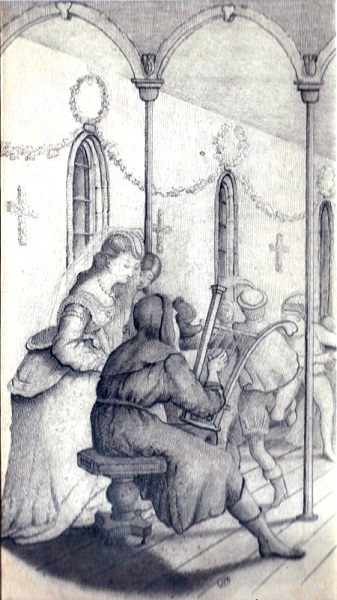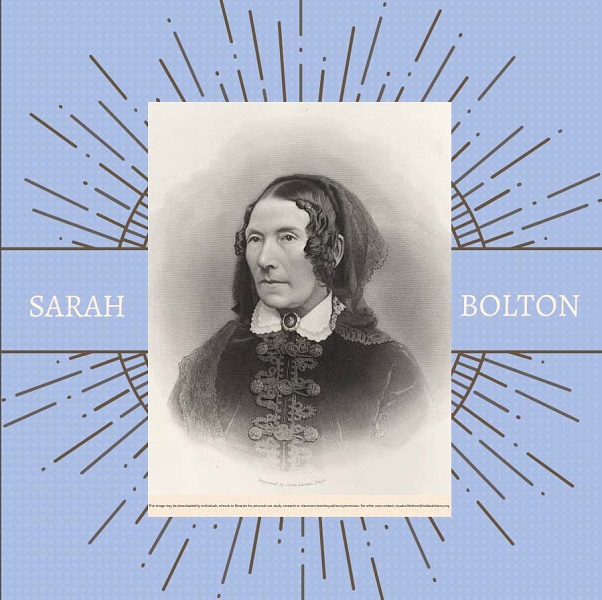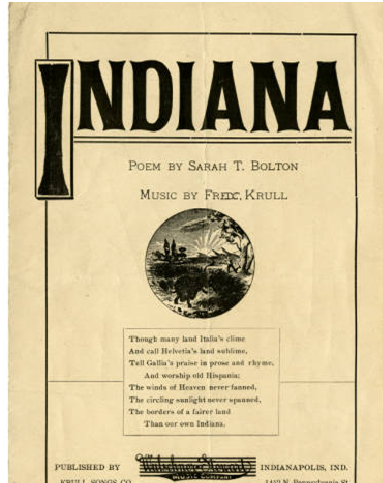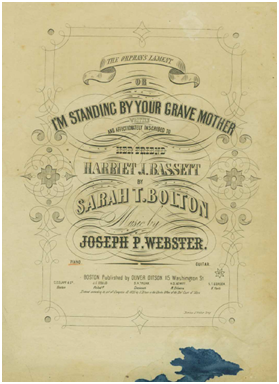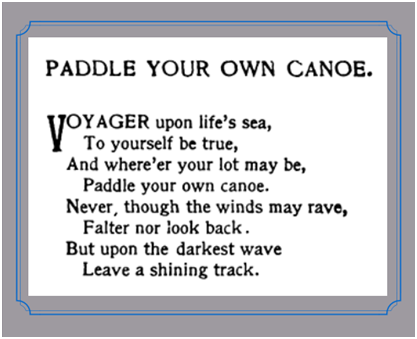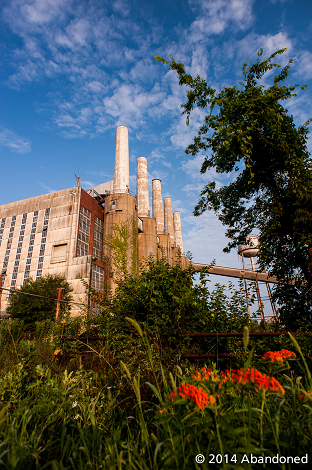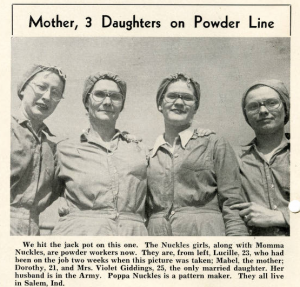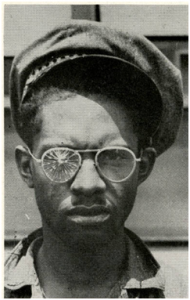
Image of Mother Theodore Guerin, Digital Image Copyright ©2006 Sisters of Providence. Saint Mary-of-the-Woods.
In the early and mid 1800s, girls and young women in Indiana had limited access to educational opportunities. Indiana historian Richard Boone noted that the state held “a prejudice against the education of girls with their brothers,” but “an impulse was early manifested” to establish schools for young women.
By 1850, approximately 14 schools for girls existed within the state. Young women also found it more difficult to obtain access to higher education during the early and middle 1800s. Most universities only allowed men to attend classes; Indiana University did not admit its first female student until 1867. During this time, however, there were dedicated individuals who worked to change the status quo. During her lifetime, Saint Theodore Guérin, recognized as a saint by the Catholic Church in 2006, provided educational opportunities to Indiana’s girls and young women through the establishment of schools, most notably Saint Mary-of-the-Woods College.
Saint Theodore Guérin was born and baptized at Etàbles in Brittany, France on October 2, 1798. Her parents, Isabelle le Fèvere and Laurent Guérin, named her Anne-Thérèse Guérin. During the first twenty-five years of Guérin’s life she faced numerous hardships. Before she reached the age of 13, she reportedly lost two brothers. When she was 15 years old, thieves robbed and murdered Guérin’s father, a French naval officer who served under Napoleon near Avignon, France. He was on furlough and heading home. After the loss of a husband and two sons, Guérin’s mother came down with a “severe illness,” leaving Anne-Thérèse Guérin to care for her mother and nine-year-old sister Marie.
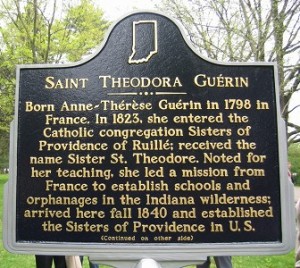
Guérin was a devout Catholic from a young age. She took her first communion at the age of ten. After ten years of caring for her mother, Anne-Thérèse Guérin left home and committed herself to becoming a nun. At the age of 25, she became a postulant at the Sisters of Providence in Ruillé, France on August 18, 1823, and received the religious name Sister Saint Theodore Guérin. Immediately following her entrance into the
convent, Sister Saint Theodore suffered from a severe illness that impaired her health for the rest of her life. She could never eat solid foods again. After her recovery, the Sisters of Providence assigned Sister Saint Theodore Guérin to missionary work in Pruilly-sur-Claise.
After a short period of time as a postulant, Sister Saint Theodore recited her first vows on September 8, 1825. She professed her perpetual vows on September 5, 1831. Around the same time she declared her first vows, Sister Saint Theodore received the appointment of Superior to the Sisters of Providence educational establishment in Rennes. For ten years, Sister Saint Theodore assisted the convent in establishing numerous schools and orphanages in Rennes, but a dispute with the Superior General of the Sisters of Providence resulted in a transfer of Sister Saint
Theodore. Her new assignment relocated her to Soulaines, a small country mission where her talents, as one biographer stated, “would find a much narrower scope.”

After only a year in Soulaines, France, Sister Saint Theodore Guérin was “voted medallion decorations” by the French Academy Board of Education in 1836. One year earlier, in 1835, the Reverend Simon Bruté, the first Bishop of Vincennes, Indiana, visited Rennes, France. He and the Reverend Célestine de la Hailandiére, soon to be Vicar-General of the Vincennes Diocese, became acquainted with the various charitable works of the Sisters of Providence. Four years later, in 1839, Bishop Bruté sent his Vicar-General on a recruiting mission to France from Indiana. The Reverend Hailandiére searched for sisters of the Catholic faith willing to move to the United States and create schools and orphanages for the Vincennes Diocese.
When the Reverend Hailandiére reached France, he received news that Bishop Bruté had died on June 26, 1839. He also obtained confirmation of his own appointment as the new Bishop of Vincennes. While in France, Bishop Hailandiére convinced six members of the Sisters of Providence to come to the United States and start a school in his Diocese. Hesitant because of her frail health, Sister Saint Theodore Guérin initially did not accept Bishop Hailandiére’s invitation, but, after careful consideration and prayer, she finally took a leadership position in the operation.
* * *
On July 12, 1840, Sister Saint Theodore and the other sisters began their journey, departing from Ruillé, France. Fourteen days later on July 26, 1840, they left for Vincennes on the ship, Cincinnati. On September 4, 1840, the Cincinnati dropped anchor in New York. After traveling from New York by train, stagecoach, and steamboat the sisters rested in Madison, Indiana. On October 1, 1840, Bishop Hailandiére and three other men told the sisters they would not be starting a school in Vincennes. The Vincennes Diocese decided Terre Haute needed their services more. After various difficulties, Sister Saint Theodore and the other nuns arrived in the middle of a thick, village-less forest four miles outside of Terre Haute on October 22, 1840. Eventually, this became the site of Saint Mary-of-the-Woods College.
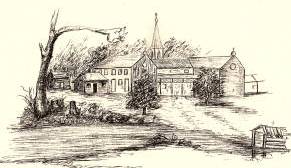
The sisters lived with a farmer, Joseph Thralls, and his family during construction of their motherhouse and Saint Mary-of-the-Woods school. Workers also cleared land for farming and chopped wood for winter. During the school’s construction, Bishop Hailandiére visited the sisters on November 12, 1840, and awarded Sister Saint Theodore the title of “Mother.” Soon thereafter the Sisters of Providence began accepting new women ready to join the convent.
The first postulant arrived on May 1, 1841. On October 9, 1841, the Wabash Courier (published in Terre Haute) advertised the “Convent and Academy,” headed by “Sister Theodora Guerin.” After the establishment of their first school at Saint Mary-of-the-Woods, the sisters’ educational influence spread quickly throughout the state. On March 21, 1842, the Sisters of Providence opened a Girls’ Boarding School in Jasper. Despite terrible hardships, the convent opened 19 schools and orphanages between 1842-1856, spanning from Evansville to Vincennes to Fort Wayne.
Perhaps the most significant difficulty faced by the sisters was a fire that destroyed their barns and granaries on October 2, 1842, burning various provisions needed for the upcoming winter. Impoverished by fire, Mother Theodore Guérin, Sister Mary Cecilia and other unnamed sisters left Terre Haute for France on April 26, 1843 in search of financial aid. One month later, Mother Theodore and her traveling companions arrived in France upon the Silvia. During their stay, Mother Theodore Guérin and Sister Mary Cecilia met with Queen Marie Amelie of France, and secured money for the voyage back to the U.S. The Queen also began taking donations that later helped fund new schools.
On November 28, 1843, Mother Theodore and the sisters left France on the Nashville. The boat headed to the Gulf of Mexico and docked in New Orleans. The passengers and crew faced numerous hardships on the voyage back to the United States. The Nashville nearly sank during a hurricane, and Mother Theodore became “seized with fever” while in New Orleans. The sisters then traveled up the Mississippi, Ohio, and Wabash rivers to return to Terre Haute. Mother Theodore Guérin and the other sisters finally returned to Saint Mary-of-the-Woods on April 1, 1844.
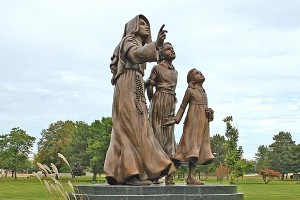
Mother Theodore Guérin continued to advance women’s educational opportunities after she returned from France. Mother Theodore Guérin and the Sisters of Providence established a seminary of higher education for women at St. Mary-of-the-Woods. On January 14, 1846, nearly six years after arriving in Terre Haute, Governor James Whitcomb approved the Articles of Incorporation for the Female Seminary of St. Mary’s of the Woods (Saint Mary-of-the-Woods College).
After 12 more years of continuous educational service with the Sisters of Providence, Mother Theodore Anne-Thérèse Guérin died on May 14, 1856. She was buried on the grounds of Saint Mary-of-the-Woods College. On December 3, 1907, Mother Theodore’s remains were moved from the burial plot to a crypt. During the re-burial process workers discovered what is considered the first sign of Mother Theodore’s holiness: her brain was still intact.
Almost a year later, on October 30, 1908, the first miracle attributed to Mother Theodore Guérin occurred. Sister Mary Theodosia, who was suffering from cancer, stopped at Mother Theodore’s tomb to pray for another ill sister, Sister Joseph Therese O’Connell. The next day Sister Theodosia’s ongoing pain vanished. A medical examination later could not find the cancerous tumor.

This unexplained occurrence piqued the interest of the Indianapolis Diocese. Two months after Sister Mary Theodosia prayed at Mother Theodore’s tomb, Bishop Joseph Chartrand of the Indianapolis Diocese wrote to the Sister’s of Providence Superior General, Mother Mary Cleophas Foley, to indicated that initial “proceedings regarding” Mother Theodore’s canonization would be discussed on December 6, 1908. Many members of the Diocese began to diligently gather the needed information about Mother Theodore Guérin, including interviewing people such as Mother Anastasie Brown who worked with the foundress.
In January 1914, the Reverend Alphonaus Smith and the Reverend John T. O’Hare officially initiated the rigorous process of canonization for Mother Theodore Guérin when they left for Rome with about 500 sealed typewritten pages of evidence. Years passed as different Catholic committees performed the needed tasks to complete Mother Theodore’s canonization. In June, 1975 members of the Indiana Academy elected the late Mother Theodore Guérin into their organization. The academy was created by the “Associated Colleges of Indiana to honor Hoosiers who have enriched the cultural and civic life of the state.”
During the 1990s the canonization of Mother Theodore gained momentum. In November 1996, Vatican medical consultants approved the healing of Sister Mary Theodosia as a miracle. Four months later, in March 1997, the Sister Theodosia miracle was approved by Vatican theologians, and acknowledged by the Cardinals in June that same year. On October 25, 1998, Pope John Paul II beatified Mother Theodore Guérin in St. Peter’s Square in Rome. The church gave her the title, Blessed Mother Theodore Guérin. Pope John Paul II stated at the ceremony that
“Her life was a perfect blend of humanness and holiness. She was fully human, fully alive, yet her deep spirituality was woven visibly through the very fabric of her life.”

In 2001, doctors diagnosed Phillip McCord, an employee at Saint Mary-of-the-Woods College, with a swollen cornea. Physicians told McCord that he needed a risky surgical procedure to transplant a new cornea. Although not a Catholic, McCord prayed to Blessed Mother Theodore Guérin for help. Slowly his condition improved over a matter of weeks, and doctors were amazed at his recovery without surgery. According to a 2006 article in the Criterion, McCord had “better than 20/20 vision in both eyes.” With the approval of this final miracle, Blessed Mother Theodore Guérin was canonized and officially determined to be a Saint on October 15, 2006. The Vatican gave the new Saint the religious name Saint Theodora Guérin, but the Sisters of Providence refer to her as Saint Mother Theodore Guérin.
In addition to her sainthood, Guérin’s ongoing legacy features her efforts to spread learning throughout Indiana. As of 2008, her most prominent endeavor, Saint Mary-of-the-Woods College, continues the mission it began under Saint Theodore Guérin, to provide women with educational opportunities. Saint Mary-of-the-Woods College enrolls 1,700 students and offers campus-based undergraduate and graduate degrees and certificate programs. After 175 years of operation, the Saint Mary-of-the-Woods’ Board of Trustees voted for the college to become fully co-educational in 2015.
To view the citations and annotations used in this post click here.
Wabash Valley Visions and Voices Digital Memory Project holds an impressive collection of digitized artifacts, and documents associated with Saint Theodore Guérin as well as historical sketches of Saint Mary-of-the-Woods College.

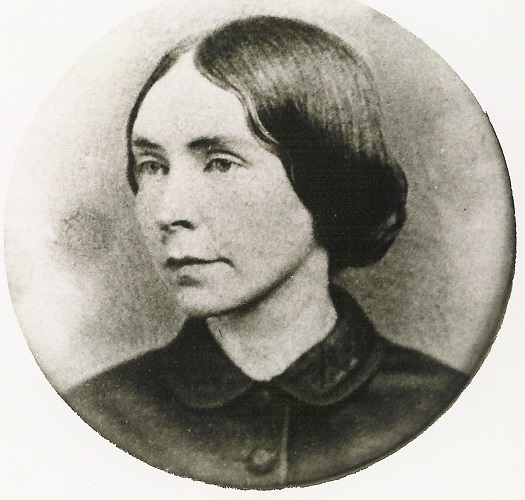
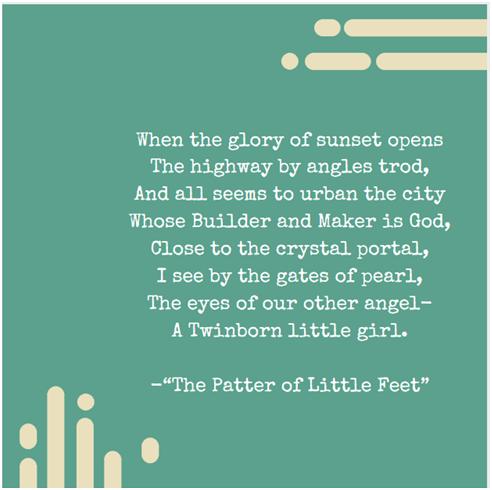 The poem goes on to describe the mother’s longing that she will someday reach heaven and hear the patter of her daughter’s feet on heaven’s floor.
The poem goes on to describe the mother’s longing that she will someday reach heaven and hear the patter of her daughter’s feet on heaven’s floor.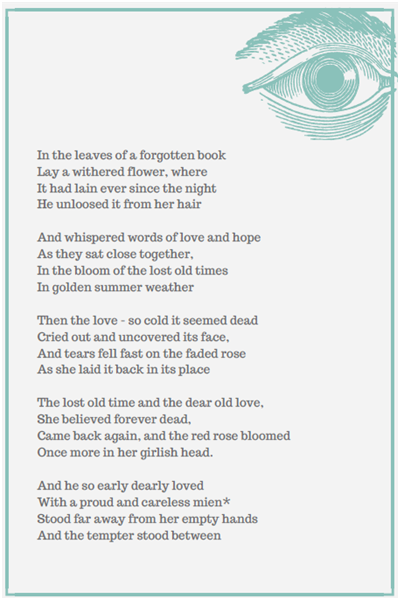
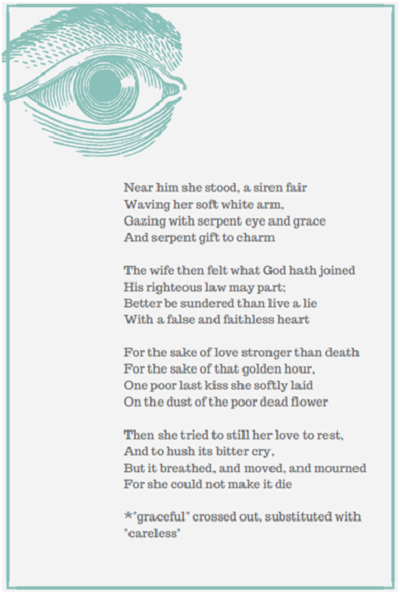 Interestingly, this poem does not seem to have raised any speculation regarding Lew’s faithfulness to Susan.
Interestingly, this poem does not seem to have raised any speculation regarding Lew’s faithfulness to Susan.